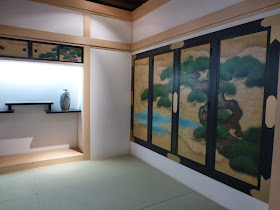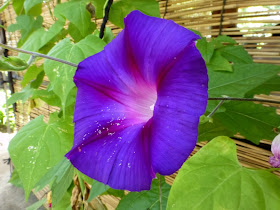Are you hungry? After I left the sake museum, I took the short walk to Tsuragajo, the castle the samurai thought was burning. While the castle survived the attack during the Boshin War, it (along with a ton more of Japanese heritage) was destroyed by the Meiji government as a sign of change. The reconstructed castle that exists now was built in 1960 and was renovated in 2011.
Approaching the northern entrance, you'll pass a few snack shops. But I didn't see any obvious place to get a quick full meal. It's a somewhat residential area; there is a sit down restaurant on the main road near the tourist bus stop.
As with most castles, Tsuraga was surrounded by a wall. It has a generally square shape, and the entry path known as masugata was shaped such that those entering the castle grounds couldn't see very far; enemies using this entry could be attacked on three sides. I've seen this at a couple other castles, and the Tokyo Imperial Palace's east garden.
After coming around the last corner, there's a nice view of the castle on top of its stone base.
This is a mushabashiri. It's a set of stairs built into the outer wall to defend the castle; it provides defensive access at the masugata.
The castle keep can be entered and explored. As a concrete reproduction, the inside doesn't have anything original
Instead, Tsuraga has a really good museum. Among other things, there are some akabeko (red cows) in one of the display cases - the town of Aizu-Wakamatsu is strongly associated with these bobbing-head figurines.
There are traditional Japanese masks, swords, and other artifacts scattered over several floors as you make your way to the top of the keep.
I thought these candles were quite interesting. I keep finding more and more Japanese crafts that are just really beautiful.
There is a tatami room area with a fake painted wall screen, so visitors can have their picture taken in a "Japanese room" that supposedly resembles a castle room. I don't know about that because this one looks pretty modern; most middle class families living in houses have at least one Japanese room.
While completing the renovations in 2011, the roof received red tiles that are authentic to the original castle design.
From the castle, you can see out over the valley to the mountains beyond. On a clear winter day I'm sure the view is even more amazing.
There is a long elevated hallway that leads to another reconstructed part of the castle.
The wall and shape of the masugata can be seen in the trees below.
After heading back downstairs, you can see a collection of weapons - here are some rifles and long bows.
There are a few displays that show the uses of the elevated hallway, such as for defense.
Here is a model of how the original wall was built.
Don't hang around beneath walkways at castles. You might find your head bashed in by a dropped rock.
Looking back to the keep...
The castle. With the red tiles and recent renovations, it's a very nice reconstruction. The structure at the end of the elevated hallway holds a gift shop. Prices inside were comparable to other souvenir shops in town.
You can walk along the top of one of the walls after leaving the keep.
As you walk around the park, you can get a few great views of the keep.
There's a traditional garden and tea house in the park, too. There are multiple buildings but I think most of them are used for display only.
The roof of a building in the teahouse garden.
Flower growing in a bamboo screen.
Another castle shot. It's very photogenic.
Roof detail.
Yes, this castle has a moat. If you use this exit - the eastern exit, you'll be on your way to the nearby Fukushima Prefectural Museum. The western exit leads to a parking lot. The moat surrounds the entire castle park.
Admission to the castle and teahouse together is 500 yen, both of which are open 8:30 to 17:00. Tea and a snack at the teahouse is an additional 500 yen. The tourist loop bus stops about 5 minutes away (Tsuragajo Kitaguchi).





























Is that mochi on a stick?
ReplyDelete